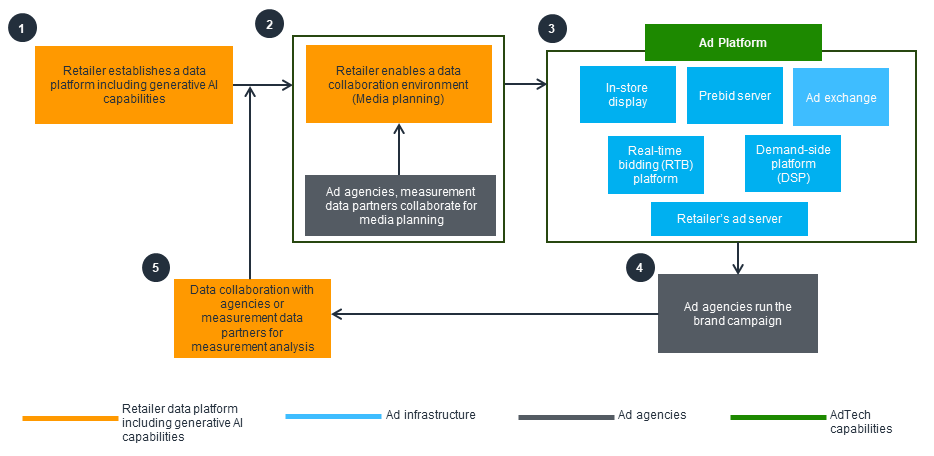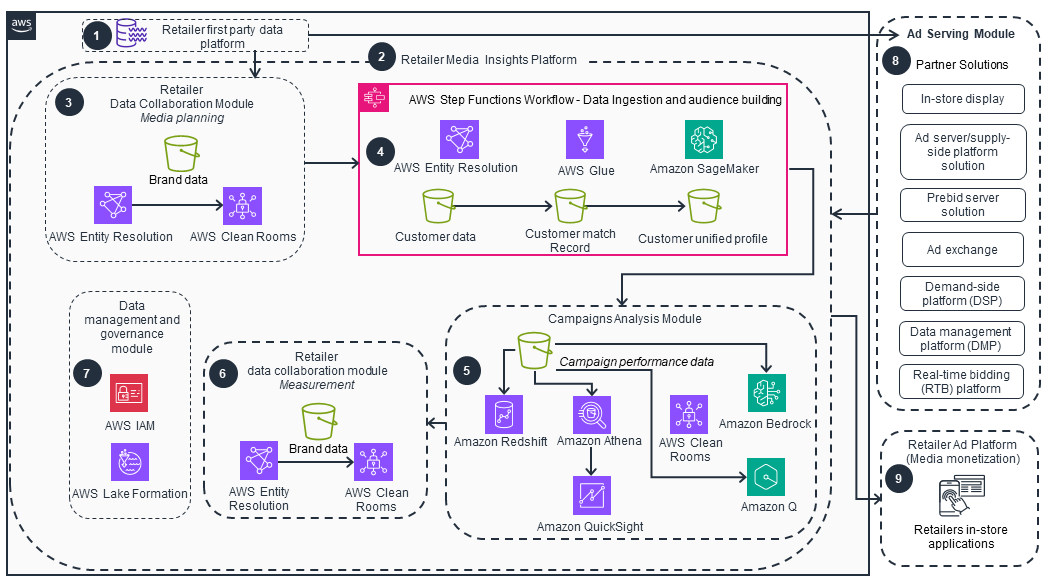- AWS Solutions Library›
- Guidance for Retail and Commerce Media Monetization on AWS
Guidance for Retail and Commerce Media Monetization on AWS
Overview
This Guidance illustrates how retailers can setup a Media Insights platform that serves as a central hub for the retailer’s commerce and media monetization using their data and analytics. Traditionally, retailers have faced challenges when wanting to fully capitalize on the value of their first-party data and online audience. They often lack the integrated data platforms, advanced analytics including generative AI capabilities, and secure data collaboration mechanisms to optimize their media monetization efforts. The Media Insights platform addresses those challenges, offering retailers a central location to transform their first-party data into a strategic asset. By using this platform, retailers can optimize their media monetization efforts and generate increased revenue through their existing channels.
How it works
Overview
This architecture diagram provides an overview of how retailers, acting as publishers, can better monetize their online audience with a Retail Media Insights platform.

Key components and workflows
This architecture diagram outlines the key components and workflows involved in enabling retailers to monetize their online audience through the Retail Media Insights platform.

Well-Architected Pillars
The architecture diagram above is an example of a Solution created with Well-Architected best practices in mind. To be fully Well-Architected, you should follow as many Well-Architected best practices as possible.
This Guidance uses Amazon Bedrock and SageMaker to enhance machine learning operations (MLOps) and streamline the ML lifecycle. It also uses AWS Clean Rooms and AWS Entity Resolution to protect the privacy of retailers, advertising agencies, and brands. These AWS services provide robust features for managing ML workflows and safeguarding sensitive data throughout the process.
Read the Operational Excellence whitepaperIAM securely manages identities and access to AWS services and resources for both the retailer and the Retail Media Insights platform. It helps ensure the creation of policies with minimum required permissions, limiting unauthorized access to resources. Lake Formation complements this by managing permissions during data sharing and improving data lake setup and security. This is particularly beneficial for the data analytics and business intelligence layer of this Guidance. Together, these services provide a robust security framework, protecting sensitive data and resources.
Read the Security whitepaperStep Functions orchestrates the data flow within the architecture by monitoring AWS Entity Resolution workflows and making API calls to Amazon Bedrock. This visual workflow service helps developers build distributed applications, automate processes, orchestrate microservices, and create data and ML pipelines using AWS services. Step Functions maintains service capacity across multiple Availability Zones, enhancing reliability. It performs API calls using scheduled or event-based triggers, allowing for automatic retries in case of failures and scalable concurrent execution. This capability helps ensure robust and efficient workflow management, even in complex scenarios involving multiple AWS services.
Amazon Bedrock and AWS Entity Resolution are fully managed services that enable businesses to focus on innovation while reducing the complexity of managing underlying resources. Specifically, Amazon Bedrock allows users to invoke LLMs through API calls for near real-time results. AWS Entity Resolution offers flexible record matching using either rule-based or ML models, with on-demand or automatic processing options. These services work in tandem to streamline data processing and analysis tasks. By handling the technical intricacies, they allow retailers to concentrate on their core objectives and use advanced AI and data matching capabilities without the burden of infrastructure management.
This architecture uses several AWS services to optimize costs and improve efficiency. For example, the Amazon S3 buckets for the campaigns analytics module use Amazon S3 Intelligent-Tiering storage class, which automatically moves data between access tiers based on usage patterns, reducing storage costs. Regular reviews of QuickSight author and reader account activity help identify and remove inactive accounts, potentially decreasing the number of required QuickSight subscriptions. Amazon Q, integrated with AWS Cost Explorer, offers a cost analysis feature that supports natural language processing for cost-related queries. This allows users to obtain cost information through simple, natural language questions rather than relying on traditional computing for cost calculations. By implementing these features, retailers can significantly reduce data storage costs, optimize QuickSight license usage, and streamline cost analysis processes.
The query reuse feature of Athena enhances efficiency and reduces costs when working with large datasets. This feature allows for the reuse of query results, eliminating the need to execute redundant SQL queries within a specified time frame. By caching and reusing results for identical queries, Athena significantly reduces the usage of compute resources. This optimization not only speeds up subsequent queries but also lowers costs associated with repeated data processing. Implementing query reuse is particularly beneficial for scenarios where multiple users or applications frequently run the same queries on large, relatively static datasets. By using this feature, retailers can improve query performance, reduce computational overhead, and optimize their Athena usage costs.
Disclaimer
Did you find what you were looking for today?
Let us know so we can improve the quality of the content on our pages